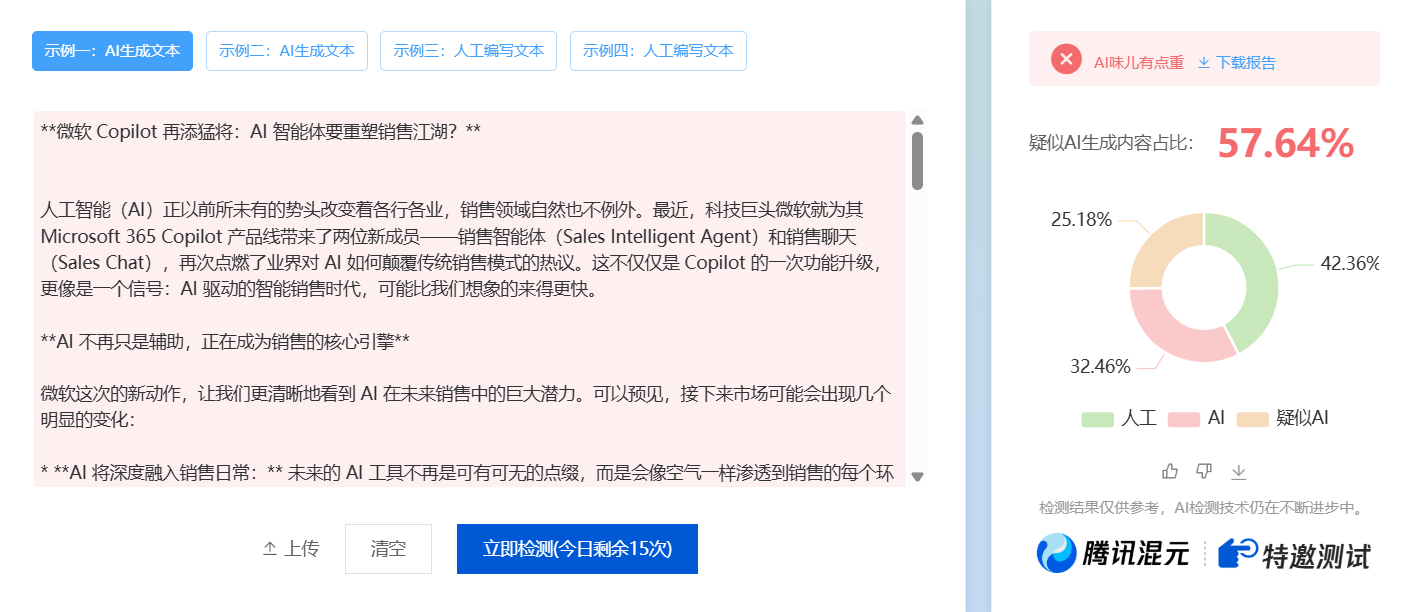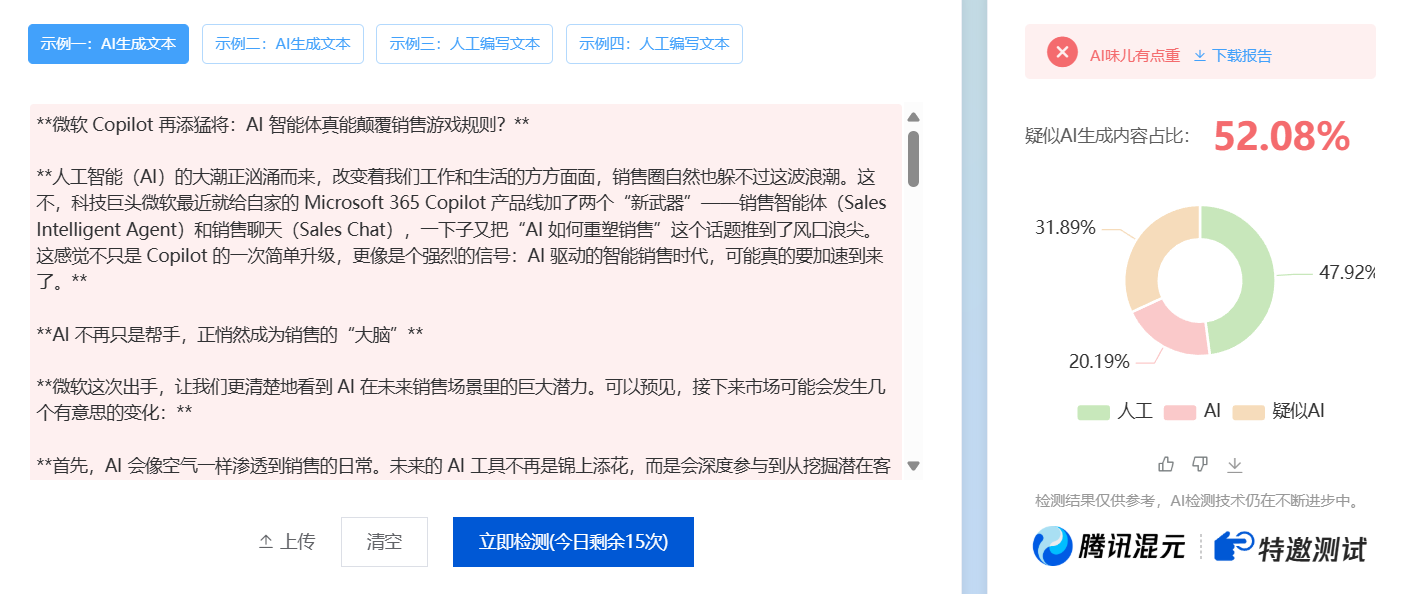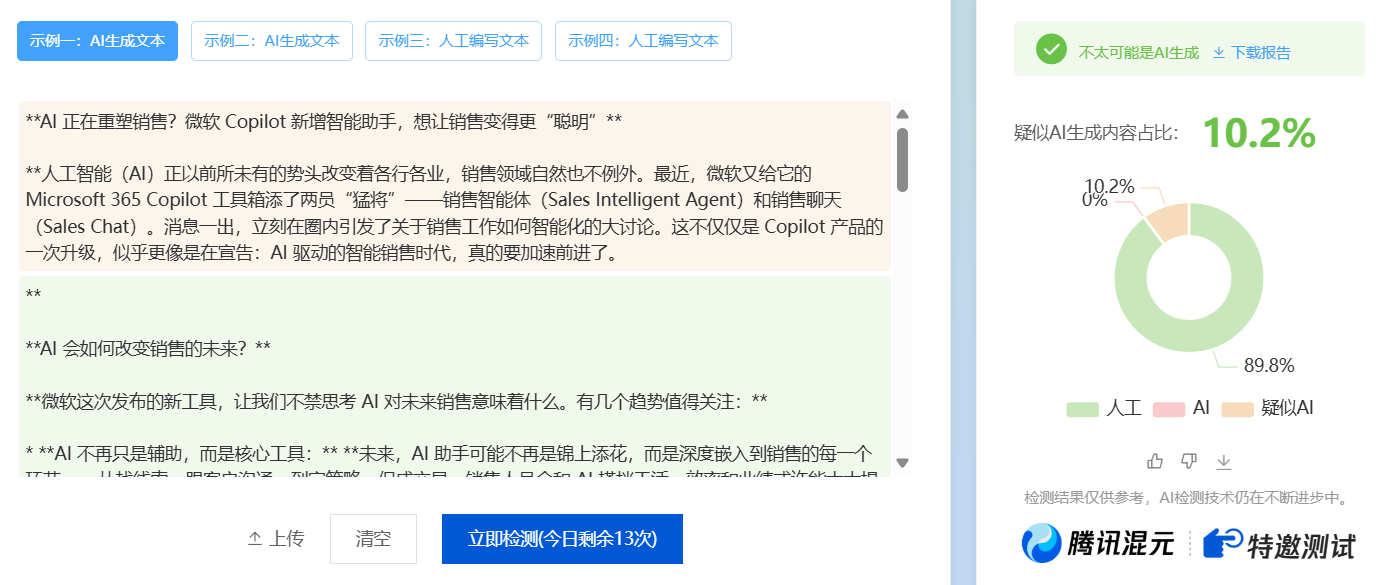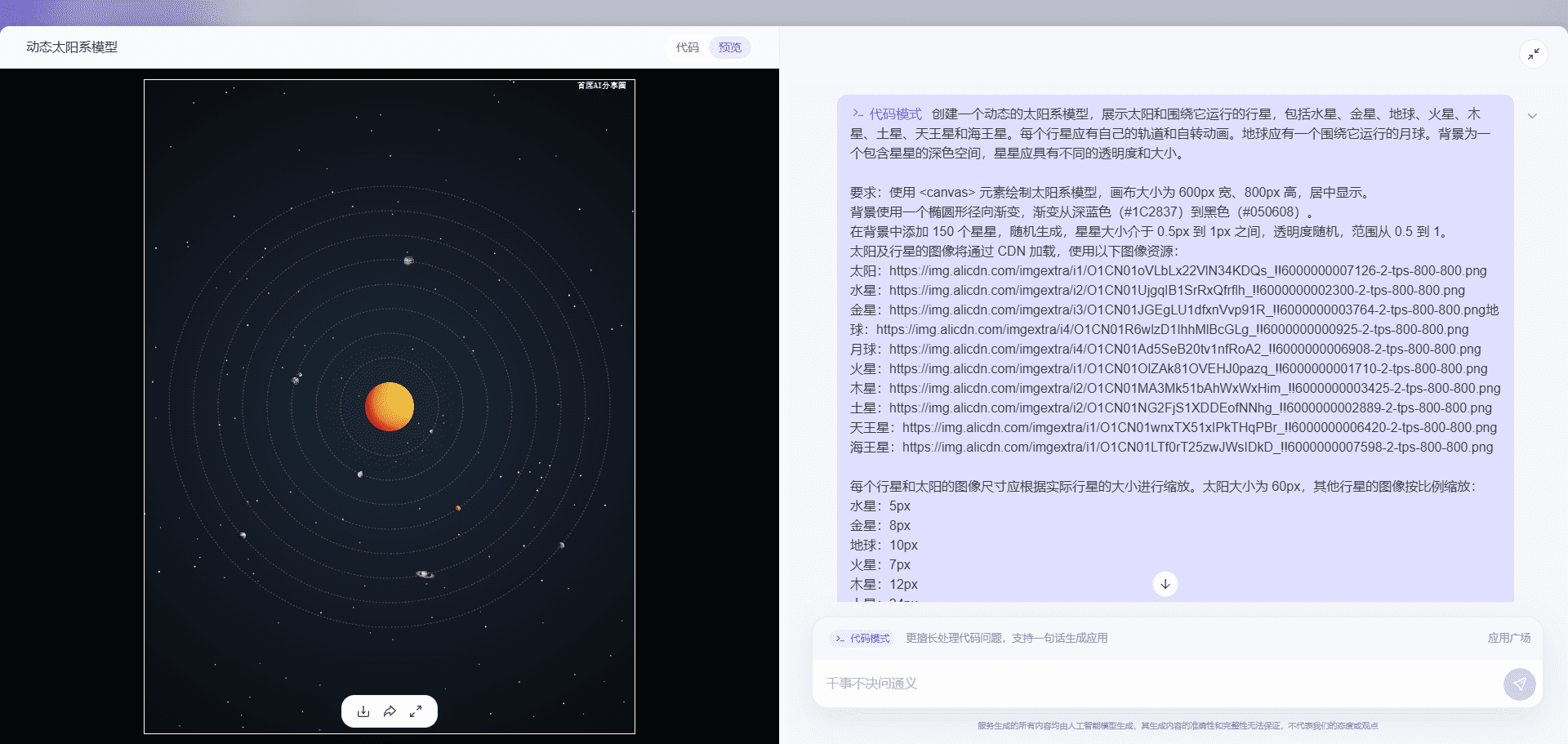自从尝试过突破朱雀大模型AI内容检测后,又发布了 科技类文章“洗稿”提示词 。以上两者在朱雀AI检测识别为“人工”的比例并不高。
原因很简单,改写文章在不破坏原文结构和信息量的前提下,基本很难做到过AI检测。要牢记:改写不同于创作。
因 Gemini 2.5 的发布,这次换一种新方法过朱雀AI检测——先让AI识别文章有哪些AI写作特征,然后规避AI特征模仿人类写作。
未加入示例提示词
**任务:** 你的任务是分析给定的文本,评估其由AI生成的可能性,并将其改写得更像人类书写。 **指令:** 1. **AI生成检测:** * 仔细阅读以下提供的文本:`[在此处插入待分析的文本]` * **评估:** 判断该文本由AI生成的可能性高低(例如:高、中、低)。 * **依据:** 详细说明你的判断理由。请结合上述“AI生成文本特征”,分析文本在结构、用词、句式、语气、流畅度、信息组织方式等方面是否符合这些特征。请明确指出具体哪些地方让你觉得像AI生成或不像AI生成。与范例(文本A/B vs A2/B2)进行对比会很有帮助。 2. **人性化改写:** * **目标:** 将上述文本改写得更像一个真人在对应的场景下写出来的。使其读起来更自然、流畅,减少机器感。参考范例文本A2和B2的风格。 * **改写要求:** * **打破模板化:** 避免过于工整、刻板的段落和句子结构。 * **调整语气与风格:** 使其更符合目标场景(例如,如果是新闻,就像记者写的;如果是评论,就像评论者写的)。可以适当增加一些引导性、评论性或略带口语化的词句(视情况而定),减少过度客观或书面化的表达。 * **丰富句式:** 使用更多样化的句子结构,长短句结合,变换表达方式。 * **增强流畅性:** 改善句子间的衔接,使其过渡更自然。 * **精简与聚焦:** 可能需要适当删减冗余信息或调整信息呈现顺序,突出重点。 * **保留核心信息:** 必须确保原文的关键信息和核心意思在改写后得以保留。 **输出格式:** 请按以下格式提供你的回答: 1. **AI生成检测结果:** * 可能性评估:[高/中/低] * 判断依据:[在此处详细说明理由,结合文本具体内容和特征分析] 2. **人性化改写后的文本:** * [在此处提供改写后的完整文本] **现在,请处理以下文本:** [贴文本]
第一轮改写

使用第一轮改写文本再次进行第二轮改写

目前效果有限,恰巧朱雀给了我们可以过AI检测的文本,我们加入到提示词中作为示例,再次尝试。
加入示例提示词
文本A:
{{{
在中国“嫦娥一号”探月卫星于明年发射之后,中国还将发射三颗“夸父”卫星“逐日”。昨天,在第36届世界空间科技大会期间,中国宇航局发言人正式对外宣布了这一宏伟计划。这一计划的实施,不仅标志着中国航天事业在深空探测领域取得了新的重大突破,也展示了中国政府对于未来航天发展的宏伟蓝图和坚定信念。
“夸父”卫星项目,作为中国古代神话中追逐太阳的英雄的名字,寓意着探索太阳的无限可能。这一项目计划在未来几年内,通过发射三颗卫星,实现对太阳的全面、深入观测。这些卫星将携带先进的观测仪器,对太阳进行全方位、多角度的观测,获取大量关于太阳的宝贵数据。这些数据不仅有助于科学家们更深入地理解太阳的物理特性,为未来的空间天气预报提供更为精准的数据支持,还将推动相关领域的科学研究和技术创新。
第一颗“夸父”卫星,计划在未来两年内发射。这颗卫星的主要任务是进行太阳风的综合观测。通过搭载的高精度仪器,它将实时监测太阳风的速度、方向、温度等关键参数,为科学家们提供太阳风的详尽数据。这些数据将有助于科学家们更好地理解太阳风对地球空间环境的影响,预测太阳活动对地球空间环境的潜在威胁,为航天器的安全运行提供更为可靠的保障。
第二颗“夸父”卫星,将在第一颗卫星发射后的两年内发射。这颗卫星的主要目标是观测太阳耀斑和日冕物质抛射现象。通过搭载的先进观测设备,它将捕捉到太阳耀斑和日冕物质抛射的清晰图像和数据,揭示这些现象背后的物理机制。这些数据将有助于科学家们更好地预测太阳活动,降低太阳活动对地球空间环境和人类活动的影响,为地球空间环境的稳定和安全提供有力支持。
第三颗“夸父”卫星,则计划在第二颗卫星发射后的两年内发射。这颗卫星的主要任务是进行太阳和地球空间环境的联合观测。通过搭载的多波段观测仪器,它将同时观测太阳和地球空间环境的变化,揭示它们之间的相互作用和影响机制。这些数据将有助于科学家们更好地理解太阳活动对地球空间环境的影响,为航天器的运行和人类活动提供更为准确的空间天气预报。
“夸父”卫星项目的实施,无疑将为中国的航天事业注入新的活力。通过这一项目,中国不仅将进一步提升在深空探测领域的技术水平,还将为全球空间科学的发展做出重要贡献。同时,“夸父”卫星项目也将激发更多年轻人对航天科技的兴趣和热情,为中国航天事业的持续发展培养更多的优秀人才。}}}
文本A2:
{{{
在中国“嫦娥一号”探月卫星于明年发射之后,中国还将发射三颗“夸父”卫星“逐日”。昨天,在第36届世界空间科学大会各国航天局圆桌会议上,中国国家航天局局长孙来燕讲解了中国未来五年航天计划,其中未来五年中国将为发射“夸父”卫星进行日地空间探测进行前期准备。
孙来燕说,目前正在对“夸父计划”进行可行性研究,未来五年当中,将完成发射的前期准备工作。据悉,“夸父计划——空间风暴、极光和空间天气探测计划”是由北京大学地球与空间科学学院涂传诒院士等人提出的。“夸父计划”将由一颗位于日地系统第一拉格朗日点(L1点)的卫星“夸父A”和两颗沿极轨共轭飞行的卫星“夸父B1”、“夸父B2”组成综合观测系统,将用于监测太阳活动导致的日地空间环境连锁变化的全过程。
“夸父A”卫星的任务是飞行到日地连线上的L1点、即距地球150万公里处进行探测,用来全天候监测太阳爆发事件的发生及其扰动在日地空间中的传播过程。由于该点具有观测太阳活动的天然优势,因此,“夸父A”选择L1点附近作为目标飞行位置,另外目前,只有美国航空航天局和欧洲空间局有为数不多的航天器,到达过L1点。而“夸父B”两颗卫星的飞行任务是实现一天24小时,一周7天连续观测北极光的分布,用来监测太阳活动导致的地球附近空间环境的整体变化。
}}}
文本B:
{{{
In reply to: personal accountability by pdundas
Afterall they can say: "Look, the patent-office, staffed by competent people that aren't us, examined the patent and granted it. We didn't have any direct involvement in the process, so how can we be held personally accountable for any mistakes or oversights?"
This argument might seem reasonable at first glance, but upon closer examination, it quickly falls apart. While it is true that the patent office is responsible for examining and granting patents, this does not absolve individuals or companies from their own responsibilities.
Firstly, those who apply for patents are often the ones who stand to gain the most from them. This means that they have a vested interest in ensuring that their applications are as strong and robust as possible. If they fail to do their due diligence and make sure that their inventions are truly novel and non-obvious, then they should be held accountable for any issues that arise.
Furthermore, even though the patent office is responsible for examining patents, it is not infallible. The patent examination process is often complex and time-consuming, and even the most competent examiners can make mistakes. This is why it is crucial for inventors and applicants to be proactive in ensuring the strength of their applications. They should carefully research prior art, make sure their inventions are properly disclosed, and work closely with patent attorneys to navigate the application process.
Additionally, personal accountability is not just about legal or ethical obligations. It is also about maintaining a sense of integrity and responsibility in one's work. If an inventor or applicant knows that there are issues with their patent application, but they still push it through the process, then they are essentially deceiving the patent office and potentially infringing on the rights of others. This kind of behavior is not only unethical, but it can also have serious legal consequences down the road.
Moreover, holding individuals and companies accountable for their actions in the patent process can help to prevent abuse and fraud. There have been numerous cases of individuals and companies filing frivolous patent applications or using patents as weapons to stifle competition. By holding these individuals and companies accountable, we can discourage such behavior and maintain a fair and level playing field in the world of innovation.
In conclusion, while the patent office plays a crucial role in examining and granting patents, this does not absolve individuals and companies from their own responsibilities. Those who apply for patents must be proactive in ensuring the strength and integrity of their applications, and they should be held accountable for any issues that arise. By doing so, we can maintain a fair and level playing field in the world of innovation and discourage abuse and fraud in the patent process.}}}
文本B2:
{{{In reply to: personal accountability by pdundas
Afterall they can say: "Look, the patent-office, staffed by competent people that aren't us, examined the patent and granted it.
It's really tricky to argue that the patent-office saw the patent as valid, yet that anyone else who *also* sees it as valid, are acting with criminal neglect and/or malevolence.
(Log in to post comments)
How much are the (US) patent office expected to know about the current state of the art? Given the number of applications relative to the number of examiners, they would have to be sufficiently familiar with every field they deal with to have an idea off the top of their head about whether or not it is original if they are to spot prior art without help. Is this really what courts assume about them?
They'd have to be, afterall, because the chief criteria are first that it's novel, and second that it's non-obvious. The definition of the latter vary somewhat by jurisdiction, but for USA it means that:
"the difference between the subject matter sought to be patented and the prior art are such that the subject matter as a whole would have been obvious to a person having ordinary skill in the art to which the subject matter pertains."
In other words, if the technique being patented would have been obvious to a person who has knowledge of formerly used techniques *and* ordinary skill in the subject-area, then that technique is not patentable.
That's what the law says - offcourse in practice it doesn't work like that. It *is* obvious to a person of ordinary skill in developing payment-solutions for webshops that shopping can be made with one click if the required information has been stored previously - and it's equally obvious how to implement this. Nevertheless the patent was granted.
A patent-examiner, in principle, has examined the application and determined that it is novel, non-obvious and useful. It's gonna be really tricky to make it stick that believing his conclusions amounts to criminal neglect.
If you *could* make it stick: "Nobody in their right mind could believe this", then you could conceivably also sue the patent-office for criminal neglect, since they'd be guilty of the same mistake.
That'd be the day -- but I ain't holding my breath.}}}
**任务:**
你的任务是分析给定的文本,评估其由AI生成的可能性,并将其改写得更像人类书写。
**背景:**
* **AI生成文本特征 (类似文本A, 文本B):** 通常表现为结构严谨、用词正式规范、句子结构可能略显单一或重复、逻辑清晰但可能缺乏人类写作中的自然流畅感、情感色彩或口语化表达。行文风格可能像官方报告、技术文档或中性陈述。
* **人类书写文本特征 (类似文本A2, 文本B2):** 风格更多样,可能包含更自然的过渡、略显口语化的表达、变化的句式、个人观点或情感的流露(即使是客观报道也可能有微妙的侧重)、有时结构不那么死板,更符合特定场景(如新闻报道、论坛回复)的语境。
**指令:**
1. **AI生成检测:**
* 仔细阅读以下提供的文本:`[在此处插入待分析的文本]`
* **评估:** 判断该文本由AI生成的可能性高低(例如:高、中、低)。
* **依据:** 详细说明你的判断理由。请结合上述“AI生成文本特征”,分析文本在结构、用词、句式、语气、流畅度、信息组织方式等方面是否符合这些特征。请明确指出具体哪些地方让你觉得像AI生成或不像AI生成。与范例(文本A/B vs A2/B2)进行对比会很有帮助。
2. **人性化改写:**
* **目标:** 将上述文本改写得更像一个真人在对应的场景下写出来的。使其读起来更自然、流畅,减少机器感。参考范例文本A2和B2的风格。
* **改写要求:**
* **打破模板化:** 避免过于工整、刻板的段落和句子结构。
* **调整语气与风格:** 使其更符合目标场景(例如,如果是新闻,就像记者写的;如果是评论,就像评论者写的)。可以适当增加一些引导性、评论性或略带口语化的词句(视情况而定),减少过度客观或书面化的表达。
* **丰富句式:** 使用更多样化的句子结构,长短句结合,变换表达方式。
* **增强流畅性:** 改善句子间的衔接,使其过渡更自然。
* **精简与聚焦:** 可能需要适当删减冗余信息或调整信息呈现顺序,突出重点。
* **保留核心信息:** 必须确保原文的关键信息和核心意思在改写后得以保留。
**输出格式:**
请按以下格式提供你的回答:
1. **AI生成检测结果:**
* 可能性评估:[高/中/低]
* 判断依据:[在此处详细说明理由,结合文本具体内容和特征分析]
2. **人性化改写后的文本:**
* [在此处提供改写后的完整文本]
**现在,请处理以下文本:**
[贴文本]
第一轮改写

这次用魔法打败了魔法,前提是依赖 Gemini 2.5 优秀的推理能力!
© 版权声明
文章版权归 AI分享圈 所有,未经允许请勿转载。
Related posts

暂无评论...




